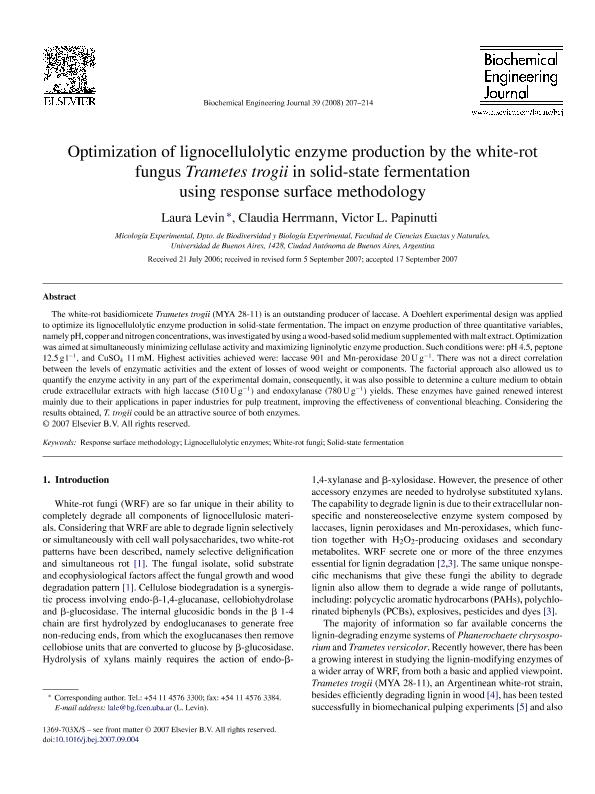Artículo
Optimization of lignocellulolytic enzyme production by the white-rot fungus Trametes trogii in solid-state fermentation using response surface methodology
Fecha de publicación:
04/2008
Editorial:
Elsevier Science Sa
Revista:
Biochemical Engineering Journal
ISSN:
1369-703X
Idioma:
Inglés
Tipo de recurso:
Artículo publicado
Clasificación temática:
Resumen
The white-rot basidiomicete Trametes trogii (MYA 28-11) is an outstanding producer of laccase. A Doehlert experimental design was applied to optimize its lignocellulolytic enzyme production in solid-state fermentation. The impact on enzyme production of three quantitative variables, namely pH, copper and nitrogen concentrations, was investigated by using a wood-based solid medium supplemented with malt extract. Optimization was aimed at simultaneously minimizing cellulase activity and maximizing ligninolytic enzyme production. Such conditions were: pH 4.5, peptone 12.5 g l-1, and CuSO4 11 mM. Highest activities achieved were: laccase 901 and Mn-peroxidase 20 U g-1. There was not a direct correlation between the levels of enzymatic activities and the extent of losses of wood weight or components. The factorial approach also allowed us to quantify the enzyme activity in any part of the experimental domain, consequently, it was also possible to determine a culture medium to obtain crude extracellular extracts with high laccase (510 U g-1) and endoxylanase (780 U g-1) yields. These enzymes have gained renewed interest mainly due to their applications in paper industries for pulp treatment, improving the effectiveness of conventional bleaching. Considering the results obtained, T. trogii could be an attractive source of both enzymes.
Archivos asociados
Licencia
Identificadores
Colecciones
Articulos(INMIBO (EX - PROPLAME))
Articulos de INSTITUTO DE MICOLOGIA Y BOTANICA
Articulos de INSTITUTO DE MICOLOGIA Y BOTANICA
Citación
Levin, Laura Noemí; Herrmann, Claudia Karina; Papinutti, Víctor Leandro; Optimization of lignocellulolytic enzyme production by the white-rot fungus Trametes trogii in solid-state fermentation using response surface methodology; Elsevier Science Sa; Biochemical Engineering Journal; 39; 1; 4-2008; 207-214
Compartir
Altmétricas




